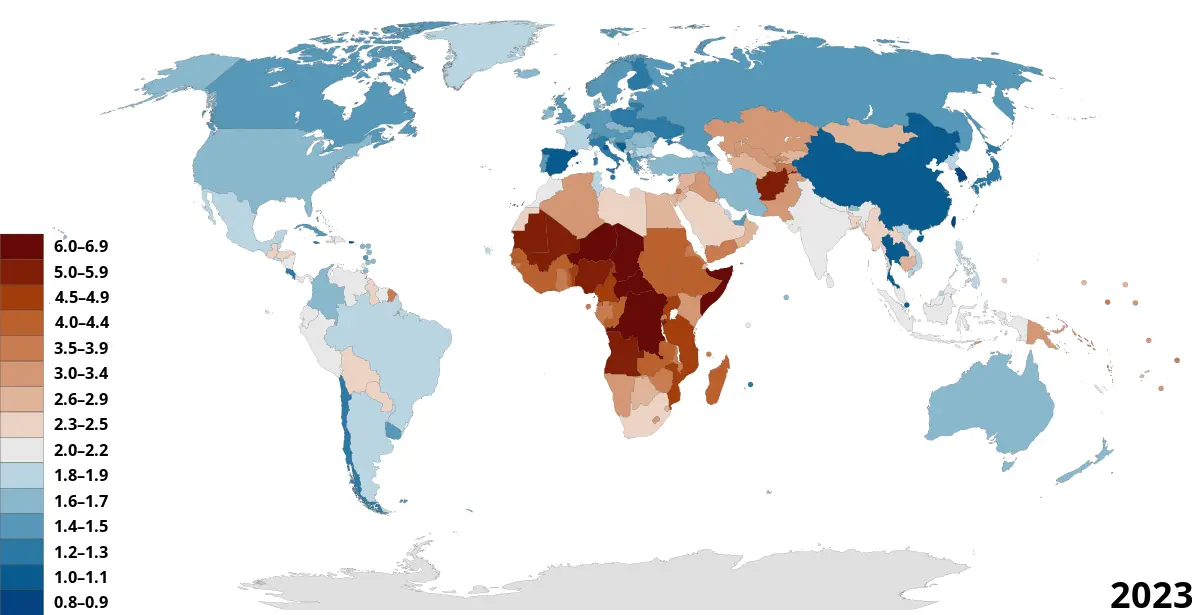
Fertility rates play a crucial role in shaping the future of a country’s population. Defined as the average number of children born to a woman over her lifetime, fertility rates provide valuable insights into population growth, demographic trends, and the overall health of a nation. By analyzing these rates, policymakers and researchers can better understand the social, economic, and cultural factors that influence population dynamics.
A high fertility rate can have far-reaching implications for a country’s development. It can lead to a rapid increase in population, placing a strain on resources, infrastructure, and public services. On the other hand, countries with low fertility rates may face challenges associated with an aging population and a shrinking workforce. Understanding the factors that contribute to high situstoto fertility rates is, therefore, essential for effective policy planning and resource allocation.

Factors influencing Highest Fertility Rates
A multitude of factors can influence a country’s fertility rate. Socioeconomic factors, cultural norms, access to healthcare, educational opportunities, and government policies all play a significant role in shaping fertility patterns. Let’s explore some of the key factors that contribute to high fertilityin different countries.
Socioeconomic factors
In many developing nations, high fertility rate are closely tied to poverty and lack of access to education and healthcare. Limited economic opportunities, inadequate infrastructure, and unstable political environments can exacerbate these challenges. In these societies, having many children may be seen as a form of social security, as children can contribute to the family’s income and provide support in old age.
Cultural norms and traditions
Cultural norms and traditions also play a significant role in determining fertility rate. In some societies, having a large family is valued and seen as a marker of status or prosperity. Religious beliefs, gender roles, and societal expectations can influence individuals’ decisions regarding family size. In countries where women have limited autonomy and control over their reproductive choices, fertility rates tend to be higher.
Healthcare and family planning
Access to healthcare services and family planning resources can have a profound impact on fertility rate. Countries with robust healthcare systems and comprehensive family planning programs tend to have lower fertility rates. These programs provide individuals with information, contraceptives, and support to plan their families according to their desired family size. In contrast, countries with limited access to healthcare and family planning services often struggle to control population growth.
The countries with the highest fertility rates
Now, let’s delve into the countries with the highest fertility rates. These countries stand out from the rest due to their exceptionally high average number of children per woman. While the specific rankings may change over time, certain countries consistently feature at the top of the list. Understanding the factors that contribute to their high fertility rate is crucial for policymakers and researchers alike.
Fertility Rates in Niger
Niger boasts one of the highest fertility rates in the world. This can be attributed to a combination of factors, including a high poverty rate, limited access to education, and cultural norms that value large families. Additionally, the lack of comprehensive family planning programs and limited healthcare services contribute to the high fertility rate in Niger. Despite efforts to address these challenges, the country continues to grapple with a rapidly growing population.
Fertility Rates in Nigeria
In Nigeria , high fertility rate are influenced by a complex interplay of socioeconomic and cultural factors. Poverty, limited educational opportunities, and a lack of healthcare infrastructure contribute to the high fertility rate. Moreover, societal expectations and traditional gender roles play a significant role in shaping individuals’ decisions regarding family size. The government has implemented various initiatives to address these challenges, but progress has been slow.
Fertility Rates in India
India , although experiencing rapid economic growth, still struggles with a high fertility rate. Despite improvements in healthcare and education, cultural norms emphasizing large families and limited access to family planning resources contribute to the high fertility rate. The government has implemented policies to promote family planning and empower women, but significant challenges remain.

Analysis of the top countries
Analyzing the countries with the highest fertility rates provides valuable insights into the unique circumstances and challenges they face. These countries often grapple with issues such as poverty, limited access to education and healthcare, and deeply ingrained cultural norms. Understanding these factors is essential for designing effective policies and interventions that address the specific challenges faced by these nations.
Moreover, it is important to recognize that high fertility rate can have both positive and negative implications for a country’s development. On one hand, a growing population can boost economic productivity and contribute to innovation and cultural diversity. On the other hand, rapid population growth can strain resources, increase unemployment rates, and exacerbate poverty. Striking a balance between population growth and sustainable development is a complex task that requires a multifaceted approach.
Implications of high fertility rates
Countries with high fertility rate face a range of implications that extend beyond the immediate challenges of resource allocation and infrastructure development. These implications can have long-term consequences for the country’s social, economic, and political landscape. Let’s explore some of the key implications associated with high fertility rates.
Population growth and demographics
High fertility contribute to rapid population growth, which can have significant implications for a country’s demographics. A rapidly growing population can strain resources, including healthcare, education, and housing. It can also lead to increased competition for jobs and limited economic opportunities, particularly in countries with limited economic diversification.
Economic development and poverty
The relationship between fertility rate and economic development is complex. While population growth can stimulate economic activity, high fertility rates can also perpetuate poverty and hinder economic progress. Limited access to education and healthcare, coupled with a large dependent population, can strain government resources and limit investments in infrastructure and social services.
Gender equality and women’s empowerment
High fertility rates often intersect with issues of gender equality and women’s empowerment. In societies where women have limited control over their reproductive choices, high fertility rate can perpetuate gender inequalities. Limited access to education, employment opportunities, and healthcare can further exacerbate these challenges, hindering women’s empowerment and overall development.
Challenges faced by countries with high fertility rates
Countries with high fertility rates face a myriad of challenges that require innovative solutions and comprehensive policy frameworks. Addressing these challenges is essential for sustainable development, poverty alleviation, and ensuring the well-being of future generations.
Overpopulation and resource scarcity
One of the primary challenges associated with high fertility rates is overpopulation and resource scarcity. As the population grows, the demand for resources such as food, water, and energy increases. Limited access to these resources can lead to food insecurity, environmental degradation, and social unrest. Developing strategies for sustainable resource management and promoting responsible consumption are crucial steps towards addressing these challenges.
Education and healthcare infrastructure
Limited access to education and healthcare infrastructure is another significant challenge faced by countries with high fertility. Investing in quality education and healthcare services is crucial for empowering individuals, reducing poverty, and improving overall well-being. Governments and international organizations must prioritize these sectors and allocate adequate resources to ensure universal access to quality education and healthcare.
Gender inequality and reproductive rights
Addressing gender inequality and promoting reproductive rights are essential for reducing high fertility. Empowering women through education, economic opportunities, and access to family planning resources can have a significant impact on fertility rates. Moreover, promoting gender equality and women’s rights is not only a matter of social justice but also a prerequisite for sustainable development.

Government policies and initiatives
Governments play a pivotal role in addressing the challenges associated with high fertility. Implementing effective policies and initiatives can have a transformative impact on population dynamics and overall development. Let’s explore some examples of government interventions aimed at reducing fertility and promoting sustainable development.
Comprehensive family planning programs
Governments can implement comprehensive family planning programs that provide individuals with information, contraceptives, and support to plan their families according to their desired family size. These programs should prioritize accessibility, affordability, and culturally sensitive approaches to ensure widespread adoption.
Investment in education and healthcare
Investing in education and healthcare is essential for reducing fertility rates and improving overall well-being. Governments should allocate adequate resources to improve the quality and accessibility of education and healthcare services. This includes building schools and healthcare facilities, training healthcare professionals, and promoting health education.
Women’s empowerment and gender equality
Promoting women’s empowerment and gender equality is critical for reducing high fertility. Governments should prioritize initiatives that empower women through education, economic opportunities, and access to reproductive health services. Additionally, addressing gender norms and stereotypes and promoting women’s participation in decision-making processes are crucial steps towards achieving gender equality.
Comparison with countries with low fertility rates
While some countries struggle with high fertility, others face the challenge of low fertility. Understanding the differences between these two groups can provide valuable insights into the factors that influence fertility patterns and population dynamics. Let’s compare countries with high and low fertility to shed light on these differences.
Economic development and societal factors
Countries with low fertility rates often have higher levels of economic development, education, and access to healthcare. Greater gender equality, urbanization, and cultural shifts towards smaller families also contribute to lower fertility. In contrast, countries with high fertility often face challenges associated with poverty, limited education, and healthcare infrastructure, and deeply ingrained cultural norms.
Fertility Rates: Aging population and workforce challenges
Countries with low fertility often face the challenge of an aging population and a shrinking workforce. This can have significant implications for economic productivity, healthcare systems, and social welfare programs. In contrast, countries with high fertility may have a larger working-age population, which can contribute to economic growth if accompanied by adequate investments in education and job creation.
Highest Fertility Rates: Government policies and initiatives
Government policies and initiatives differ significantly between countries with high and low fertility. While countries with low fertility rate often prioritize policies that support work-life balance, childcare, and family-friendly workplace practices, countries with high fertility focus on expanding access to education, healthcare, and family planning services.
Conclusion: Highest Fertility Rate
Understanding the countries with the highest fertility rate provides valuable insights into the complex interplay of social, economic, and cultural factors that shape population dynamics. These countries face unique challenges associated with rapid population growth and resource scarcity, which require innovative solutions and comprehensive policy frameworks.
By addressing the root causes of high fertility rate, such as poverty, limited access to education and healthcare, and gender inequality, governments can promote sustainable development, reduce poverty, and improve overall well-being. Investing in education, healthcare infrastructure, and women’s empowerment is crucial for achieving these goals.








